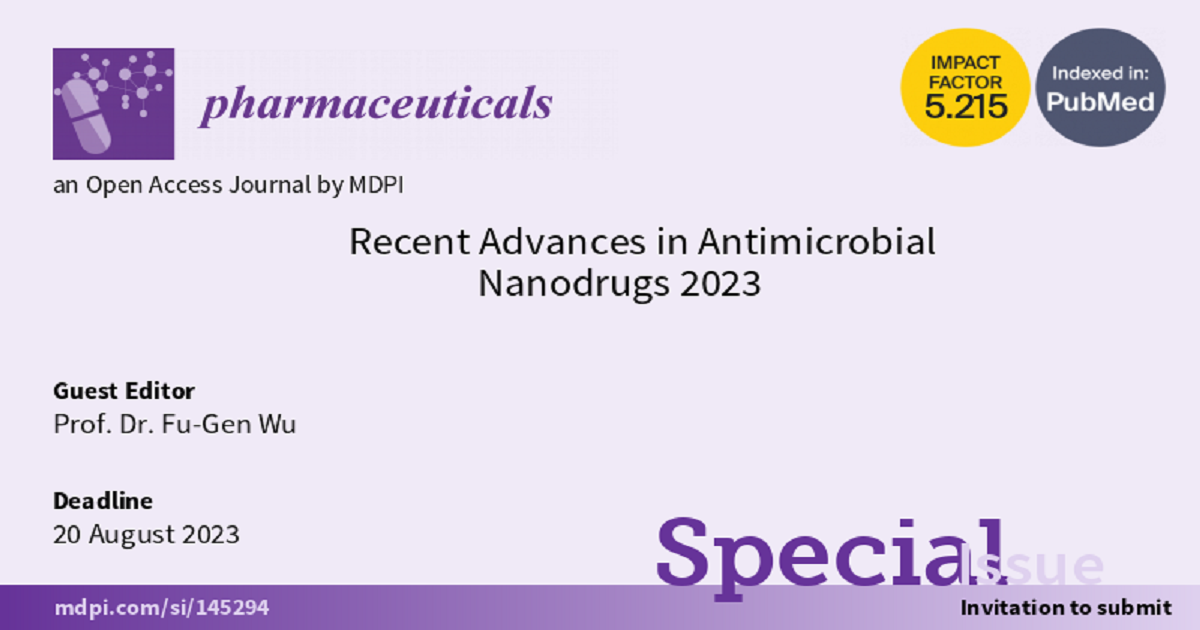Recent Advances in Antimicrobial Nanodrugs 2023
A special issue of Pharmaceuticals (ISSN 1424-8247). This special issue belongs to the section "Pharmaceutical Technology".
Deadline for manuscript submissions: closed (20 August 2023) | Viewed by 1988

Special Issue Editor
Interests: biosensors; drug delivery; nanomedicine; cancer therapy; antibacterial; pharmaceuticals
Special Issues, Collections and Topics in MDPI journals
Special Issue Information
Dear Colleagues,
Microbial infections have always threatened public health, and the situation is becoming worse because some strains of these microorganisms have developed drug resistance to some drugs, such as conventional antibiotics. With the rapid development of nanotechnology and nanomaterials, an increasing number of nanodrugs capable of fighting against various microorganisms (e.g., bacteria, fungi, and viruses) have been designed and prepared. Their diversified size, shape, and chemical characteristics enable nanomaterials to facilitate molecular interactions with the microorganisms, and the high surface-to-volume ratio allows the incorporation of abundant functional moieties to these nanomaterials, thus promoting multivalent interactions with the microorganism. To date, the commonly used antimicrobial nanomaterials include conventional metal (Ag, Cu, Zn, and Ti)-containing nanoagents, two-dimensional nanoagents (e.g., graphene materials, layered double hydroxides, transition-metal dichalcogenides, graphitic carbon nitride, MXenes, black phosphorus, and their derivatives), polymeric nanomaterials, nanomicelles and nanovesicles, carbon dots and silicon nanoparticles, aggregation-induced emission (AIE) nanodots, nanocomposite materials, etc. In addition, nanomaterials with specific light-, heat-, electricity-, magnetic-field-, and ultrasound-responsive properties as well as excellent antimicrobial activity have also attracted the interest of an increasing number of researchers. Common examples include nanoagents with photodynamic therapy capacity and sonodynamic therapy activity. Further, nanozymes with antimicrobial activity have also drawn tremendous research interest from many researchers worldwide. In addition, chemodynamic therapy that utilizes Fenton or Fenton-like reactions to kill microbial cells represents an emerging research direction. Finally, nanomaterials decorated with conventional antibiotics have also shown the potential to achieve enhanced antimicrobial capacity compared to free antibiotics.
The journal Pharmaceuticals invites both original research articles and reviews regarding the use of nanomaterials and nanodrugs for antimicrobial applications. The related topics include: metal-based nanodrugs for antimicrobial applications, metal-free nanodrugs for antimicrobial applications, and hybrid nanodrugs for antimicrobial applications. We also welcome papers that investigate the interaction mechanisms between nanomaterials/nanodrugs and microorganisms (bacteria, fungi, and viruses). The collection of manuscripts will be published as a Special Issue of the journal.
Prof. Dr. Fu-Gen Wu
Guest Editor
Manuscript Submission Information
Manuscripts should be submitted online at www.mdpi.com by registering and logging in to this website. Once you are registered, click here to go to the submission form. Manuscripts can be submitted until the deadline. All submissions that pass pre-check are peer-reviewed. Accepted papers will be published continuously in the journal (as soon as accepted) and will be listed together on the special issue website. Research articles, review articles as well as short communications are invited. For planned papers, a title and short abstract (about 100 words) can be sent to the Editorial Office for announcement on this website.
Submitted manuscripts should not have been published previously, nor be under consideration for publication elsewhere (except conference proceedings papers). All manuscripts are thoroughly refereed through a single-blind peer-review process. A guide for authors and other relevant information for submission of manuscripts is available on the Instructions for Authors page. Pharmaceuticals is an international peer-reviewed open access monthly journal published by MDPI.
Please visit the Instructions for Authors page before submitting a manuscript. The Article Processing Charge (APC) for publication in this open access journal is 2900 CHF (Swiss Francs). Submitted papers should be well formatted and use good English. Authors may use MDPI's English editing service prior to publication or during author revisions.
Keywords
- nanomaterials
- nanoagents
- bacteria
- antibacterial
- antimicrobial
- biofilms
- drug resistance
- antibiotics
- phototherapy
- nanozymes






